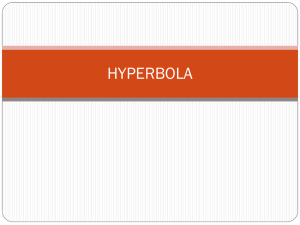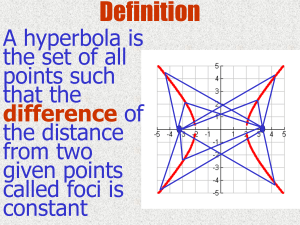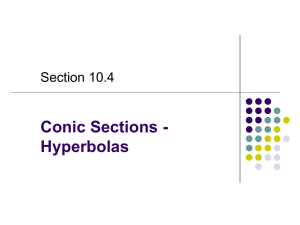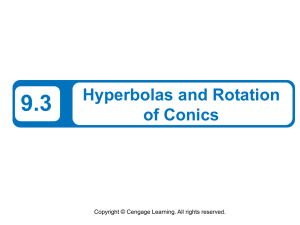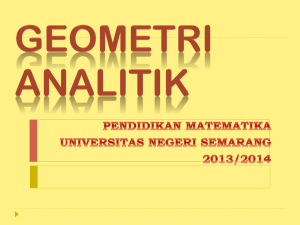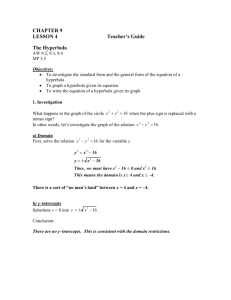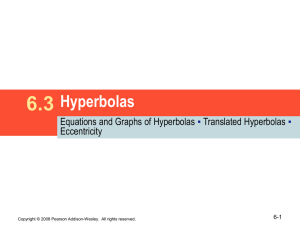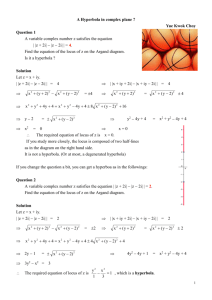Sec 11.3
advertisement
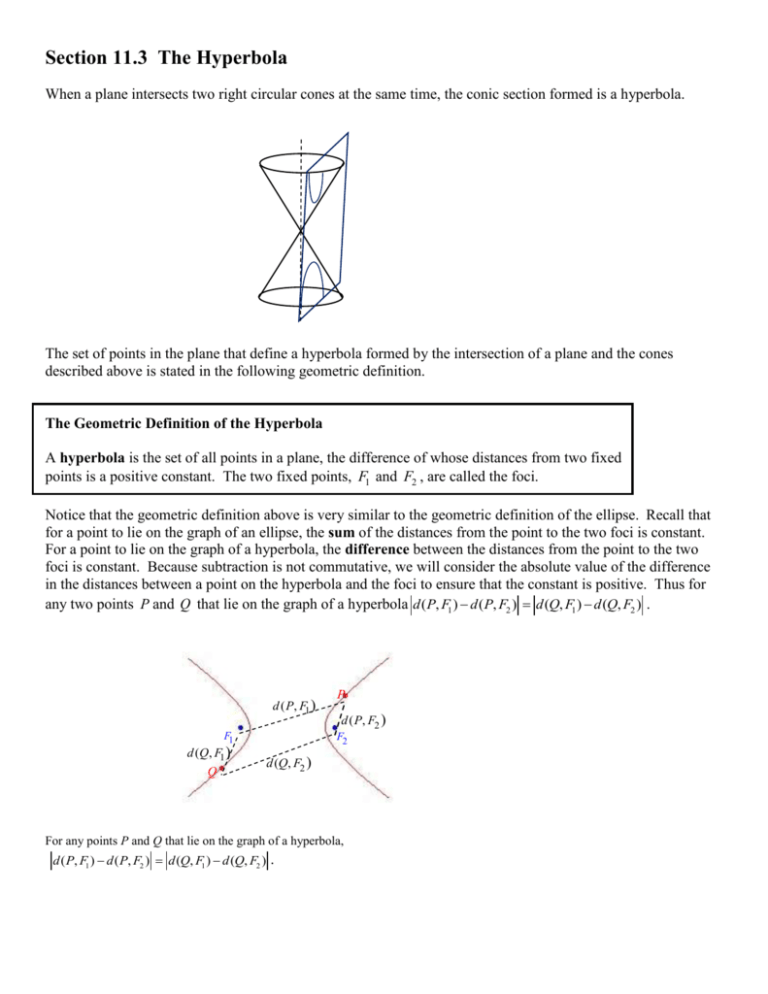
Section 11.3 The Hyperbola When a plane intersects two right circular cones at the same time, the conic section formed is a hyperbola. The set of points in the plane that define a hyperbola formed by the intersection of a plane and the cones described above is stated in the following geometric definition. The Geometric Definition of the Hyperbola A hyperbola is the set of all points in a plane, the difference of whose distances from two fixed points is a positive constant. The two fixed points, F1 and F2 , are called the foci. Notice that the geometric definition above is very similar to the geometric definition of the ellipse. Recall that for a point to lie on the graph of an ellipse, the sum of the distances from the point to the two foci is constant. For a point to lie on the graph of a hyperbola, the difference between the distances from the point to the two foci is constant. Because subtraction is not commutative, we will consider the absolute value of the difference in the distances between a point on the hyperbola and the foci to ensure that the constant is positive. Thus for any two points P and Q that lie on the graph of a hyperbola d ( P, F1 ) d ( P, F2 ) d (Q, F1 ) d (Q, F2 ) . d ( P, F1 ) F1 d (Q, F1 ) Q P d ( P, F2 ) F2 d (Q, F2 ) For any points P and Q that lie on the graph of a hyperbola, d ( P, F1 ) d ( P, F2 ) d (Q, F1 ) d (Q, F2 ) . Objective 1 Sketching the Graph of a Hyperbola The graph of a hyperbola has two branches. Each branch looks somewhat like a parabola but are certainly not parabolas because the branches do not satisfy the geometric definition of the parabola. Every hyperbola has a center, two vertices and two foci. The vertices are located at the endpoints of an invisible line segment called the transverse axis. The transverse axis is either parallel to the x-axis (horizontal transverse axis) or it is parallel to the y-axis (vertical transverse axis). The center of a hyperbola is located midway between the two vertices (or two foci). The hyperbola has another invisible line segment called the conjugate axis which passes through the center and lies perpendicular to the transverse axis. Each branch of the hyperbola approaches (but never intersects) a pair of lines called asymptotes. A reference rectangle is typically used as a guide to help sketch the asymptotes. The reference rectangle is an imaginary rectangle whose midpoints of each side are the vertices of the hyperbola or the endpoints of the conjugate axis. The asymptotes pass diagonally through opposite corners of the reference rectangle. transverse axis conjugate axis Focus transverse axis Focus Focus asymptotes Vertices conjugate axis Vertices Focus asymptotes Hyperbola with a Horizontal Transverse axis Hyperbola with a Vertical Transverse Axis To derive the equation of a hyperbola, consider a hyperbola with a horizontal transverse axis centered at ( h, k ) . If the distance between the center and either vertex is a 0 then the coordinates of the vertices are V1 (h a, k ) and V2 (h a, k ) and length of the transverse axis is equal to 2a. If c 0 is the distance between the center and either foci then the foci have coordinates F1 (h c, k ) and F2 (h c, k ) . See Figure 23. P ( x, y ) k V2 (h a, k ) V1 (h a, k ) F1 (h c, k ) ( h, k ) c hc ha F2 (h c, k ) a h ha hc By the geometric definition of a hyperbola we know that for any point P ( x, y ) that lies on the hyperbola, the difference of the distances from P to the two foci is a constant. It can be shown that this constant is equal to 2a, the length of the transverse axis. Fact 1 for Hyperbolas Given the foci of a hyperbola F1 and F2 and any point P that lies on the graph of the hyperbola, the difference of the distances between P and the foci is equal to 2a . In other words, d (V1, F1 ) d (V1, F2 ) 2a . The constant 2a represents the length of the transverse axis. Once we know that the constant stated in the geometric definition is equal to 2a, we can derive the equation of a hyperbola. Standard Equations of a Hyperbola with center ( h, k ) Horizontal Transverse Axis x h 2 y k 2 b2 a2 1 F1 (h c, k ) and F2 (h c, k ) . Vertices: V1 (h a, k ) and V2 (h a, k ) . Endpoints of conjugate axis: (h b, k ) and (h b, k ) b2 c 2 a 2 Asymptotes: y k ba ( x h) Foci: V1 ( h ( h, k b ) a, k ) k F1 ( h c, k ) a2 x h b2 c) V2 ( h, k 2 1 Foci: F1 (h c, k ) and F2 (h c, k ) . Vertices: V1 (h, k a) and V2 (h, k a) . Endpoints of conjugate axis: (h b, k ) and (h b, k ) b2 c 2 a 2 Asymptotes: y k ba ( x h) F2 ( h c, k ) h Vertical Transverse Axis y k a, k ) ( h, k b ) F2 ( h, k 2 V2 ( h k ( h b, k ) ( h b, k ) F1 ( h, k h a) V1 ( h, k c) a) The two hyperbola equations are nearly identical except for two differences. The x-terms are positive and the y –terms are negative in the equation with a horizontal transverse axis. The signs are reversed in the equation with a vertical transverse axis. Also note that a 2 appears in the denominator of the positive squared term in each equation. We can derive the equations of the asymptotes by using the point-slope form of the equation of a line. If h 0 and k 0 , then the hyperbola is centered at the origin. Hyperbolas centered at the origin have the following equations. Standard Equations of a Hyperbola with the Center at the Origin: x2 y 2 1 a 2 b2 y b y2 x2 1 a 2 b2 x a (0, a) (0, c) (0, b) (a, 0) y a x b (a, 0) (b, 0) ( c, 0) (b, 0) (c, 0) (0, b) y b a (0, a) x (0, c) y a b x
